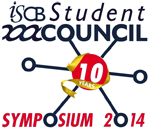Tutorials Program
ISMB 2014 will feature two (2) half-day tutorial sessions on Saturday, July 12, 2014 one day prior to the conference scientific program. Tutorials are held on the same day as the second day of the SIGs and Satellite meetings.
Tutorial attendees will be able to register using the on-line registration system. Tutorial participants must be registered for the ISMB conference to attend a tutorial. Attendees will receive a Tutorial Entry Pass (ticket) at the time they register on site. Tutorial handouts and electronic notes can be picked up at on-site registration desk at the Hynes Convention Centre. Lunch is included in the registration fee for attendees registering for two tutorials. Those attending one tutorial only have the option to purchase a lunch ticket during on-line registration.
Tutorial 1: Computational Metagenomics Techniques and Challenges
July 12, 2014
8:30 am - 12:30 pm
Location: Hynes Convention Center
Room: 107
Presenters:
Curtis Huttenhower, Harvard School of Public Health, Boston, United StatesTitus Brown, Michigan State University, East Lansing, United States
Microbial ecology is one of many fields that have benefitted greatly from technical advances in DNA sequencing. In particular, low-cost culture-independent sequencing has made metagenomic and metatranscriptomic surveys of microbial communities practical, including bacteria, archaea, viruses, and fungi associated with the human body, other hosts, and the environment. The resulting data have stimulated the development of many new computational approaches to meta'omic sequence analysis, including metagenomic assembly, microbial identification, and gene, transcript, and pathway metabolic profiling.
We will present a high-level introduction to computational metagenomics, highlighting the state-of-the-art in the field as well as outstanding challenges. These include an introduction to the biological goals of typical meta'omic studies and the bioinformatic processes currently available to achieve them. This will briefly summarize the major aspects of metagenomics analysis to be covered here: reference genome-based community composition and functional profiling, along with methods for constructing new genomic references by using de novo assembly. We will discuss the challenges associated with precisely quantifying members of a microbial community and functional analysis of the gene families in a community, the association of those gene families with their source organisms, and the combination of gene families into pathways for metabolic profiling. Finally, as sequencing technologies deliver more data for the same price, our ability to examine complex microbial communities using sequencing grows. For environmental communities, many fewer reference genomes or transcriptomes are typically available than for human-associated microbes, and the substantial diversity of many communities means that terabases of sequencing may be needed to recover a significant fraction of the community metagenome. We will discuss our growing body of work on large-scale de novo assembly, reference free methods for investigating community coverage, and diversity estimation for shotgun sequencing data. The tutorial will include standardized protocols for microbial profiling, functional profiling, and metagenome/metatranscriptome assembly with benchmarks and examples.
Segata N, Boernigen D, Tickle TL, Morgan XC, Garrett WS, Huttenhower C. "Computational meta'omics for microbial community studies." Mol Syst Biol 2013, http://www.ncbi.nlm.nih.gov/pubmed/23670539
Pell J, Hintze A, Canino-Koning R, Howe A, Tiedje JM, Brown CT. "Scaling metagenome sequence assembly with probabilistic de Bruijn graphs." PNAS 2012, http://www.ncbi.nlm.nih.gov/pubmed/22847406
Note: Please bring your own laptop to the tutorial.
Tutorial 2: Wikipedia: WikiProject Computational Biology/ISMB 2014
July 12, 2014
1:30 pm - 4:30 pm
Location: Hynes Convention Center
Room: 107
Presenters:
Daniel Mietchen, Museum für Naturkunde Berlin, Germany
Ben Moore, University of Edinburgh, Scotland
- WikiProject Computational Biology
In this tutorial, we will provide a practical introduction to editing Wikipedia for scientists. By the end of the course, participants will understand the basics of editing and have made actual contributions to Wikipedia articles. Each participant will be required to bring some pre-prepared written material, images or multimedia files to add to an article of their choice in any language version of Wikipedia. In addition, we will teach the participants about the etiquette of being a Wikipedia editor as well as helping them to avoid some of the pitfalls that new editors sometimes come across. We will also introduce the PLOS Computational Biology Topic Pages destined for the English Wikipedia, inform about the ISCB Wikipedia Competition and provide an overview of some of the sister platforms of Wikipedia, notably Wikidata and Wikimedia Commons, and their coverage of Computational Biology.
Note: Please bring your own computer and prepare some materials for you to add to Wikipedia during the tutorial
Level: General


